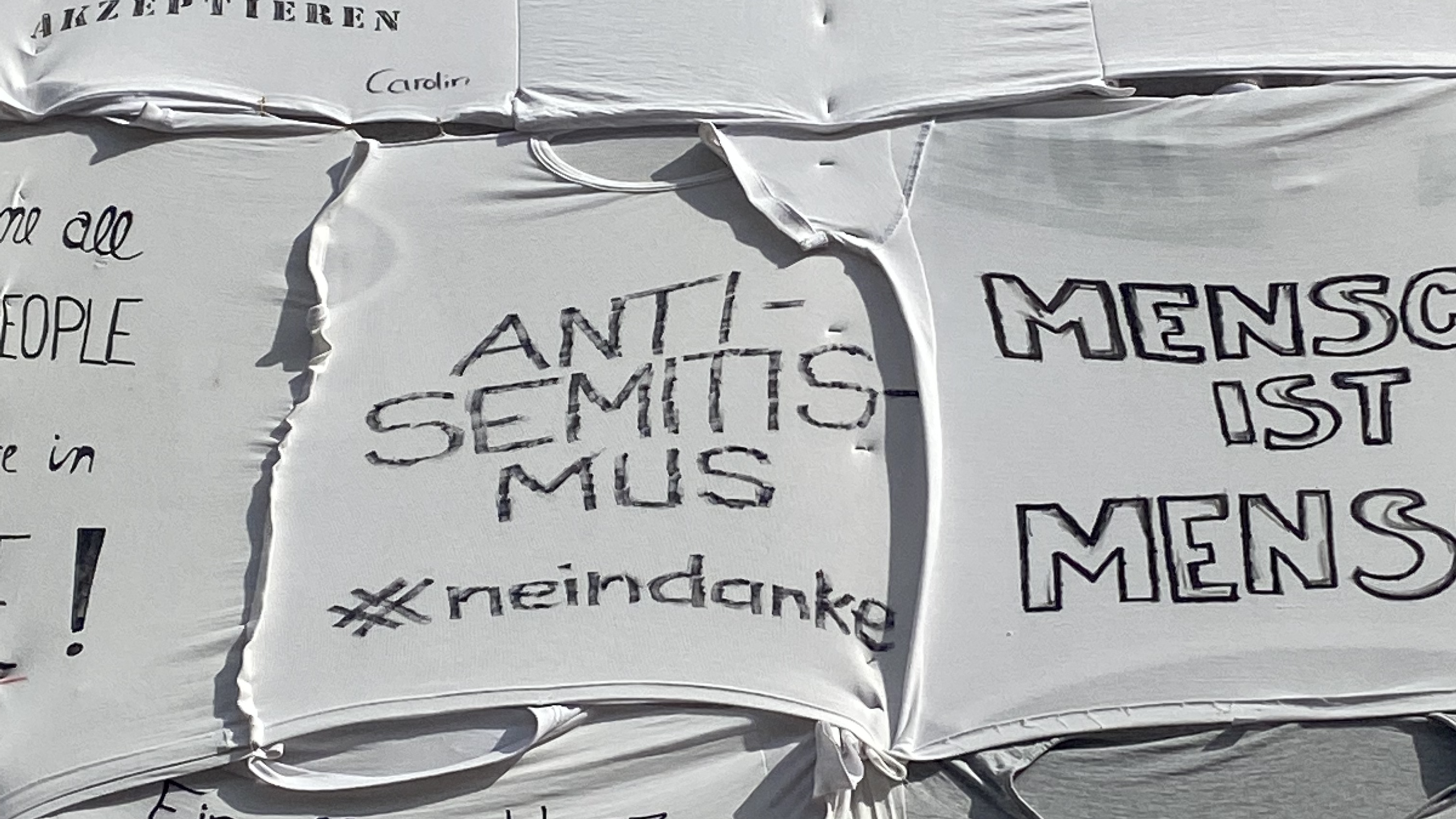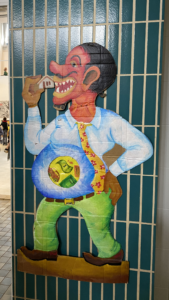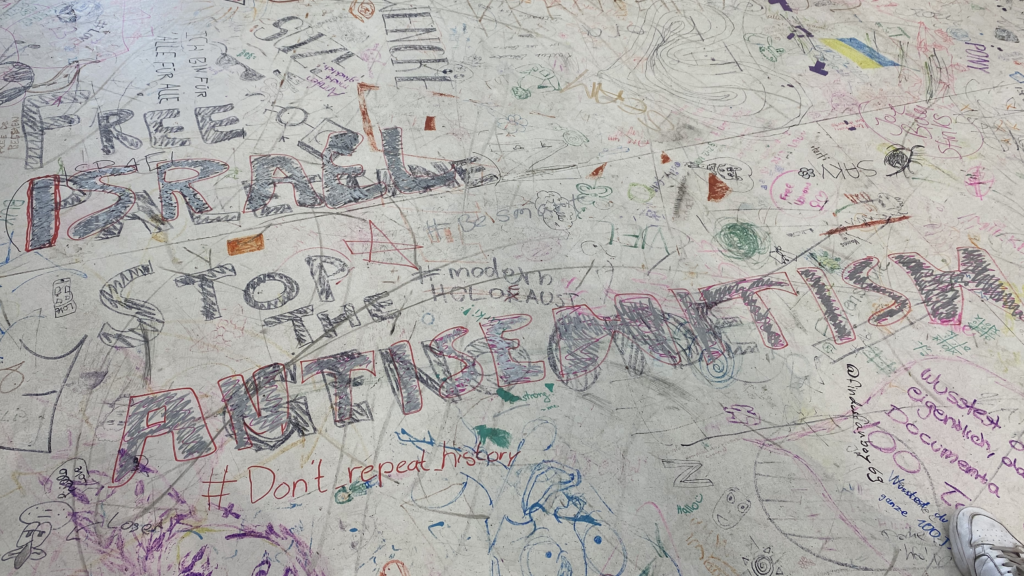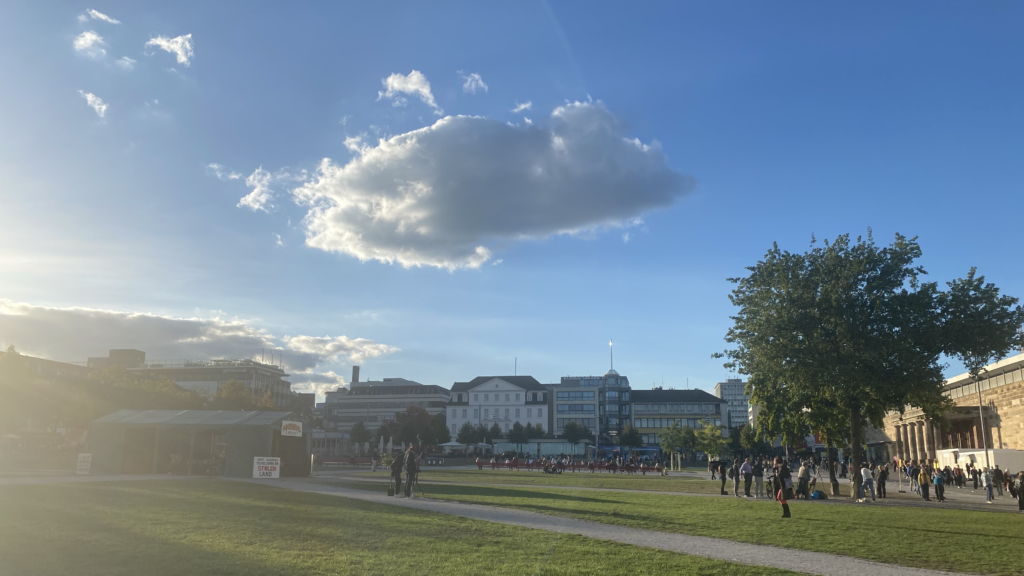Jules Moskovits, Jannis Niedick, & Agata Maria Kraj
December 21, 2022
Accusations, criticism, polarization. After a summer filled with discussions about (purportedly) antisemitic artwork at the world’s largest contemporary art fair, we too ventured to Kassel at the end of September to gain a first-hand impression of the hotly debated documenta fifteen. This year’s iteration of documenta centered on voices from the Global South; voices that often go unheard at art events like this one and more generally in the public discourse of the Global North.
By now, documenta fifteen may have come and gone, but as instances such as the events around the play “Vögel” or the antisemitic rhetoric spewed by Rapper Ye (Kanye West) have shown, questions of antisemitism in art and culture are far from rare. They flare up on a regular basis. Since our visit to documenta, our team has deliberated extensively on the discussions around documenta. We would like to share some of our thoughts, for the next antisemitism debate is sure to come.
Parallels and Many Open Questions
At the time of our trip, the RESPOND! team had been analyzing potentially antisemitic social media content collected in our first study. We saw numerous parallels between the data we encountered in our work on the one hand, and the discussions around antisemitism prompted by the art exhibition on the other.
This brought up several questions for us. Ultimately, the aim of our research project is to teach young people to respond to antisemitic hate speech competently, in ways that feel empowering to them, protect those who are targets of the hate, and help curb the proliferation of hate in the future. How can we teach young media users to react thoughtfully to the hate they encounter, when the discussion around documenta fifteen has shown that recognizing antisemitism in the first place can be difficult and contentious? Where in the picture of colonialism and marginalization does the global community place antisemitism? How can we educate about antisemitism, honoring the Jewish experience, as well as advocate for those who are suffering discrimination and racism in this postcolonial society?
Antisemitism? Not here!?

Nobody wants to be perceived as an antisemite (or at least the vast majority of “mainstream” society doesn’t). Be it at the documenta or on social media, individuals and institutions are quick to avow their rejection of antisemitism. Concurrently, there seems to be a lack of understanding when it comes to the versatility and covertness in which antisemitism can manifest. For centuries, antisemitic ideas and stereotypes have been used to construct seemingly rational explanations for the world’s problems. These undertones continue to tinge society’s lenses to this day, seeping past demarcations of political orientation. Professing a stance “against antisemitism” is relatively meaningless when this pledge disregards the possibility that antisemitism exists anywhere but in far-right fringe groups.
Thus, when attention is drawn to antisemitic expressions within the mainstream, those accused often respond defensively and reject the charge of antisemitism. Scientific findings are not acknowledged. Jewish voices are rarely heard in these matters. Instead, Jewish people are portrayed as “never-ending troublemakers and killjoys” (International Auschwitz Committee, 2022). This line of argument ultimately reinforces antisemitic narratives, once again raising the question of whether Jews themselves are not behind this in order to cover up unpopular criticism. We saw this reflex at documenta, and we see it every day in social media.
Oversimplification and Dangerous Dichotomies

At its core, antisemitic argumentation ascribes a devious quality to Jewish people, painting them as the secret beneficiaries of any tragedy that befalls the world. Undoubtedly, we need to address political and economic injustices around the world. We need to hear marginalized voices. However, an oversimplified depiction of injustices oftentimes engenders questions–implicit as they might be-about who is responsible for these inequalities. That paves the way for a classically antisemitic explanation of the world and its evils. An explicit mention of Jews need not be present in order for antisemitic narratives to be replicated. Separating the world into good and evil where the evil side is characterized by symbols of power, wealth, greed, and deceitfulness can suffice.
The postcolonial discourse oftentimes makes use of this dichotomy–David versus Goliath–fixating on Israel in particular, ironically cast here in the role of Goliath. Both at the documenta and on social media, in today’s discussions around (in)justice and power, Israel often serves as the prototypical symbol of evil, the aggressor and colonizer responsible for the world’s crises. Siding with the supposed underdog becomes an easy way to demonstrate one’s commitment to social justice. The fact that such argumentation severely oversimplifies historical and political realities appears secondary to those who propone it.
At documenta fifteen, advocating for a “free Palestine” seemed a cornerstone to not only several artists, but also to at least a few dedicated visitors: No matter which exhibit, whenever visitors had the opportunity to co-contribute, the slogan was typically easy to spot…and allusions to the Holocaust often followed. In contrast, contributions centering on the lived experiences of people in Afghanistan, Kurdish regions, Iran, Somalia, the Democratic Republic of Congo, or of indigenous nations in North, Central, and South America were rare.

This phenomenon reminds us of the social media posts we collected in Study 1. Despite all the various injustices in the world, expressions of solidarity with Palestine are particularly frequent. Such solidarity in many cases leads to the demonization of the state of Israel and the denial of its right to exist. Often manifesting itself as comparisons between Israel and Nazi Germany, Russia’s aggression against Ukraine, or simply in the use of well-known anti-Jewish stereotypes, such as “child murderers” or “well poisoners,” Israel is painted as the evil par excellence on the world’s political map.
–
–
A Missed Opportunity
What the experience of attending the documenta fifteen made clear to our team was the need to discuss difficult topics openly, empathetically, and collectively. We as a society have a certain responsibility to ensure that all marginalized voices are heard. The artists’ collective ruangrupa and the organizers of documenta fifteen had ostensibly set out to do just that.
In our hyperconnected world, we are constantly surrounded by a plethora of perspectives. Everyone can have a say. But nuance is important. To us, what transpired around documenta served as a reminder to try placing honestly empathetic exchanges at the center of our societal discourse. To attempt to engage in debates in a way that does not oversimplify complex realities into a dichotomy of good versus evil, wrong versus right. We believe we should collectively strive to discuss issues of postcolonialism, antisemitism, and racism, hearing multiple viewpoints without perpetuating or exacerbating injustices. In part through our project, we hope that Jewish voices specifically, as well as, by extension, those of other marginalized groups, are heard.
To us, the public debate around documenta has failed to do this. For the moment, the notion that Jewish people are attempting to control our cosmopolitan discourse and decide what may and may not be said once again remains. We are concerned that this is an aftereffect that will stick and fuel increasingly polarized debates in social media.
Jewish voices were not heard throughout the documenta fifteen discussions despite countless opportunities to include them in the debate. If we as a society truly want to overcome all instances of injustice and marginalization, learning from the devolved documenta fifteen debate seems imperative as we move forward.
–

–
Links
https://documenta-fifteen.de/en/
https://www.sueddeutsche.de/muenchen/voegel-muenchen-rias-theaterstueck-metropoltheater-1.5716473